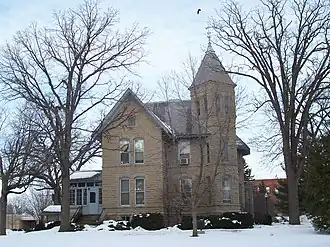Oviatt House
Oviatt House | |
 Oviatt House | |
  | |
Interactive map showing the location of Oviatt House | |
| Location | 842 Algoma Blvd., Oshkosh, Wisconsin |
|---|---|
| Coordinates | 44°01′38″N 88°33′06″W / 44.02722°N 88.55167°W |
| Area | 1.2 acres (0.49 ha) |
| Built | 1883 |
| Architect | William Waters |
| Architectural style | Gothic Revival |
| NRHP reference No. | 79000121[1] |
| Added to NRHP | August 27, 1979 |
The Oviatt House is located in Oshkosh, Wisconsin.
History
The house was designed by Waters and built in 1883 for Moses Hooper. Hooper was an Oshkosh attorney who represented Kimberly-Clark among others, and was such an authority on riparian rights that he appeared before the US Supreme Court repeatedly. In 1900 the house was bought by Dr. Charles Oviatt, a noted surgeon who insisted that nuns assisting in surgery wear sterilized garb rather than woolen habits, and eventually received a letter of agreement from Pope Leo XIII.[2]
After Oviatt's death, the house was purchased by what is now the University of Wisconsin-Oshkosh. The school has used it as a girl's dormitory, the president's residence and a charity headquarters.[3] In 1979, the house was listed on the National Register of Historic Places and it was also listed on the State Register of Historic Places in 1989.[4]
It is located in the Oshkosh State Normal School Historic District.
References
- ^ "National Register Information System". National Register of Historic Places. National Park Service. July 9, 2010.
- ^ Noyes, Edward (February 21, 1979). "Moses Hooper House". NRHP Inventory-Nomination Form. US Dept. of the Interior. National Park Service. Retrieved April 18, 2015.
- ^ "House Tour: Oviatt House". University of Wisconsin-Oshkosh. Retrieved April 9, 2018.
- ^ "842 Algoma Blvd". Wisconsin Historical Society. Retrieved April 9, 2018.
